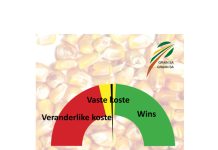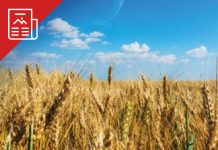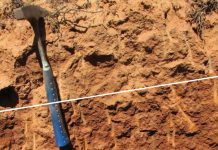Soil is the most fundamental resource for the farmer, without which food and natural fibre cannot be produced. This article forms part of a series to highlight this resource. In the next three articles in the series, the most important physical properties of soil will be discussed. However, the interaction of soil and water, which also falls under soil physics, will be dealt with later.

Particle size distribution (texture)
The texture of the soil refers to the ratio between the various particle size fractions, viz. sand, silt and clay, as they occur in the soil. A soil that mainly comprises sandy material, has a coarse texture, while a soil that is dominated by clay, has a fine texture.
Soil is classified into texture classes according to the specific combination of sand, silt and clay. The texture triangle (Figure 1) is used to subdivide a specific soil sample into a specific texture class, for example, clayey loam, silty loam, silty clay, sandy loam, loam, clay and sandy clay loam. The diameter of sand is between 2 mm and 0,02 mm, that of silt is between 0,02 mm and 0,002 mm, while particles smaller than 0,002 in diameter are classified as clay and other colloidal material. The relative sizes of these particles to each other are indicated in Figure 2.

Soil texture has a major influence on the usability of soils for crop cultivation, specific activities such as tilling practices, irrigation, plant nutrition, water retention capability and engineering aspects. Texture is a very stable characteristic and changes with great difficulty, if at all. For that reason, a sandy soil remains a sandy soil and clayey remains clay. Texture is therefore the normal starting point in investigating soil problems.
Clay normally has a high water retention capability, is aerated poorly, has poor drainage (as little as <1 mm/hour), has a higher organic material content than sand, it warms slowly during spring, offers resistance to underground compaction, offers resistance to wind erosion, is a good provider of plant nutrients, is a well buffered against pH changes, has causes delayed leaching of water, is hard when dry, but sticky when wet, has a changeable swelling/shrinkage ability, is chemically and physically active and has a high cation exchange capacity (depending on the clay mineralogy).
Specific surface area
The specific surface area of soil refers to the total surface of all the soil particles per mass. The standard unit in which it is expressed, is m2/gram of soil. Fine sand usually has a relatively small specific surface of about 0,1 m2/gram, that of fine silt is about 1m2/gram and the specific surface area of clay usually varies between 10 and 1000 m2/gram, depending on the clay mineralogy.
Adsorption of water, various plant nutrients and attraction forces between soil particles, are all dependent on the surface area of the soil. For that reason, the surface area has a major influence on various soil properties.
Bulk density
The bulk density refers to the mass of a specific volume of undisturbed dry soil. It is usually expressed as gram/cm3 or as kg/m3. The typical bulk density of a fine sandy soil under natural conditions is about 1,5 gram/cm3 or 1 500 kg/m3. A fine and well-structured clay soil has a typical gross density of 1,3 gram/cm3 or 1 300 kg/m3. Compacted sub-soils can have a bulk density of more than 2,0 g/cm3. The growth of most plant roots is handicapped when the bulk density is greater than 1,6 g/cm3. The structural units of certain clayey soils can have a very high bulk density, for example 2,2 g/cm3 in prismatic B-horizons.
When soil is tilled, the bulk density is reduced and the porosity is increased. This promotes water infiltration, air movement and root penetration. The main problem of compaction due to tractor and land vehicle traffic, the so-called plough pans or plough compactions, is precisely an increase in the bulk density to levels higher than those plant roots can deal with.
The presence of more organic material usually lowers the bulk density of soils. When soils are tilled, the organic material content of the soil also decreases over about 10 to 20 years to levels of about 40% to 50% of the original levels. The result is that the bulk density also degrades together with the organic material content.
Porosity or pore volume
The pores in the soil are of great importance for water retention capability, water movement, air movement, aeration, microbial life, biochemical reactivity and root development. Almost all the chemical and biological processes take place in the water in the pores. Oxygen is also usually needed and therefore the right amount of pores is important for optimal plant growth.
When soil is irrigated or wetted during a rain shower, almost all the pores in the top soil layer are filled with water immediately thereafter. As the water moves deeper into the profile, the largest pores are emptied first and are once again filled with air. Later, the smaller pores are emptied and are filled with air. As the plant roots withdraw the water, the increasingly smaller pores are drained and filled with air. In this way, the soil becomes drier, but also more aerated.
Porosity refers to the percentage of the soil volume which comprises pores. An undisturbed soil under natural conditions will have a typical porosity of about 50%. This means the soil comprises 50% pores and 50% soil particles. When soil is compacted, the porosity decreases. The porosity of deeper soil layers is usually lower than that of the topsoil. The lower the porosity, the fewer the pores that can be filled with water. Soils with a low porosity also tend to become waterlogged, as there is less space for air.
Another interesting characteristic of pores is pore size. Sandy soils usually have more large (macro) pores than clay, while clay therefore has more smaller (micro) pores. The total pore volume of a well-structured clay soil is usually in the region of 50% to 60%, while that of sandy soil is often less than 45%. Compacted sub-soils can have a porosity of as little as 25%, which leads to poor aeration and high resistance to root penetration. Water and air move more readily through macro-pores. In contrast, the micro pores in a damp soil are largely filled with water, which restricts air flow in and out of the soil.
Aeration
Aeration of the uppermost portion of the soil profile is necessary for the growth of the majority of plants. It is specifically oxygen that is used during respiration to release energy, while carbon dioxide is released. Bacteria, fungi and other soil microbes in the soil also use oxygen. The microbes that break down plant residue in the presence of oxygen, are the greatest users of oxygen in soil, regardless of whether there is plant growth or not!
These respiration processes lower the oxygen levels in the soil to levels lower than those in the atmosphere and raise carbon dioxide levels to higher levels than those in the atmosphere. This tendency increases with depth in the soil profile.
The existence of the difference in oxygen levels between the atmosphere and the soil air, is known as a gradient, and causes oxygen to move into the soil and carbon dioxide to move out of the soil. This process is the core of gaseous exchange between the soil and the atmosphere. If the soil is crusted, the gas exchange is negatively affected and the growth of seedlings in particular is hampered by this. The cultivation of such a soil restores the gas exchange.
When the oxygen levels decrease to a very low level during wet conditions, the microbes use sources other than oxygen, e.g. nitrate and iron, during respiration. Substances that are toxic for plants, may be formed in the process. These soil layers usually develop a mottled appearance, which may be used as an indication of water saturation.
Under these oxygen-lacking conditions, iron moves from the parts without oxygen to the richer oxygenated areas, where it precipitates as red and yellow mottles (Figure 3). As a result of the poor water movement, such soils should preferably not be irrigated.

In contrast, well-aerated soils are red in colour (Figure 4) as a result of the presence of oxidised iron (red rusted iron). Such soils should preferably be chosen for crop production and especially for irrigation.

For further information, please contact Martiens du Plessis at 072 285 5414 or martiens@nwk.co.za or Cornie van Huyssteen at 051 401 9247 or vanhuysteencw@ufs.ac.za.
References
The following sources have been used extensively during the compilation of this article:
- Brady, NC. 1990. The nature and properties of soils. 10th ed. Macmillan publishing company: New York.
- Du T Burger, R. 1979. Soil Science 115. Unpublished class notes for GKD115. University of the Free State: Bloemfontein.
- Marshall, TJ and Holmes, JW. 1979. Soil Physics. Cambridge University Press: Cambridge.
- Van Huyssteen, CW. 2009. Soil Ecology. Unpublished class notes for GKD214. University of the Free State: Bloemfontein.

















